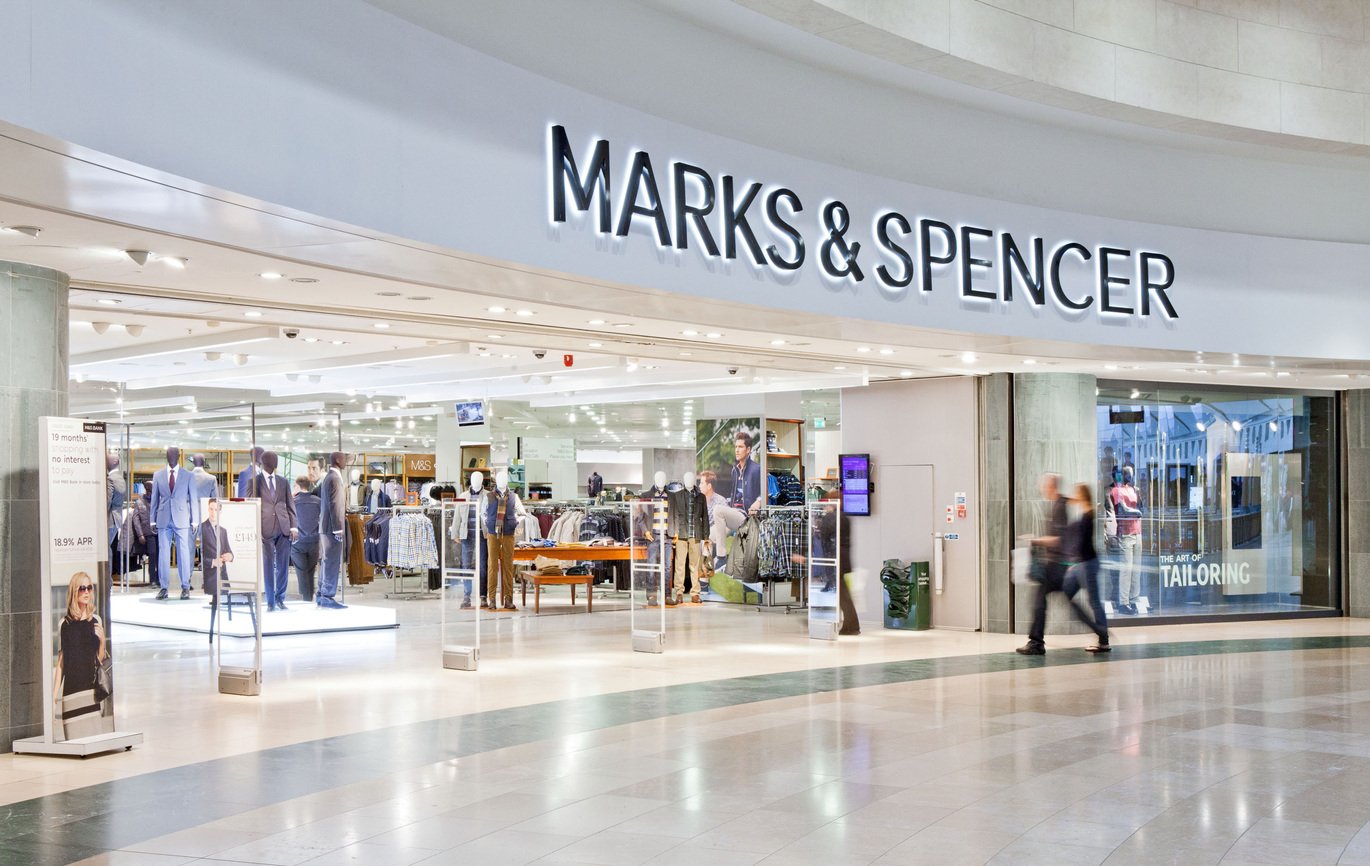Marks and Spencer Group Plc (LON:MKS) has announced its half year results for 26 weeks ended 30 September 2023.
Strong first half results
· Profit before tax and adjusting items of £360.2m (2022/23: £205.5m)
· Statutory profit before tax of £325.6m (2022/23: £208.5m)
· Food sales up 14.7%; adjusted operating profit £164.9m (2022/23: £71.8m) and margin of 4.3%
· Clothing & Home sales1 up 5.7%; adjusted operating profit £223.4m (2022/23: £171.4m) and margin of 12.1%
· Ocado Retail share of adjusted loss £23.4m (2022/23: share of loss £0.7m)
· International constant currency sales up 3.9%; adjusted operating profit £43.4m (2022/23: £39.0m)
· Stronger balance sheet: free cash flow reducing net debt and interest costs. Restoration of dividend of 1p per share.
Strategy to reshape M&S is delivering
· Food driving volume and share reflecting value investment, product innovation and quality upgrades
· Clothing & Home building improved style and value perceptions and increasing full price sales mix
· Ocado Retail reset progress; early stages of investment in value, service and increased M&S range
· Structural cost reduction programme on track with savings of over £100m delivered in the first half
· Accelerating store rotation; new full line stores and renewals performing ahead of plan
· Progress on supply chain modernisation; Gist benefits on track; C&H early savings from network plan
· More to do to drive online growth and improve returns on data, digital and technology investment
· Reshaping with a clearer vision, purpose and performance-driven culture to drive execution and pace
Stuart Machin, Chief Executive said:
“Our strategy to reshape M&S for growth has delivered strong results in the first half. We have maintained our relentless focus on trusted value, giving our customers exceptional quality product at the best possible price. In Food, we delivered over 500 quality upgrades and invested over £30m in price, lowering the price of 200 products and locking prices on 150 customer favourites. Our lead on quality perception widened and value perception continued to improve. In Clothing & Home we backed lines with authority across core and seasonal product, maintaining our lead on quality and value perception and improving our style credentials. As a result, we’ve sold more product and served more customers across Food and Clothing & Home, with both businesses outperforming the market.
Sales growth was supported by our investment in store rotation, which continued at pace. Three full line stores opened and six were renewed, all attracting new customers and performing ahead of plan. Our cost reduction programme is on track with over £100m savings delivered in the half and investment in supply chain modernisation driving efficiencies, translating volume growth to improved margin and profitability.
I am clear that if we serve our customers well, we serve our shareholders well, and our unrelenting focus on trusted value is matched by disciplined capital allocation. We have further strengthened our balance sheet and net debt position, with an interim dividend payment being made to shareholders for the first time in four years.
Looking ahead, trading momentum has been maintained through October, with customers responding positively to our Christmas ranges. There will be challenges and headwinds in the year ahead and progress won’t be linear, but we are ambitious for future growth and are driving what is in our control.
Everyone at M&S makes change happen and I want to thank my colleagues for their contribution to these results. I also want to thank them in advance for what they are about to do. All of us will be sleeves rolled up, out in stores and distribution centres, bringing the magic of M&S alive for our customers this Christmas. In summary – we’re only just beginning. Lots done, lots to do, lots of opportunity.”
| Group Results (26 weeks ended) | 30 September 23 | 1 October 22 | Change (%/£) |
| Statutory revenue | £6,134.0m | £5,538.2m | 10.8% |
| Sales1 | £6,164.4m | £5,563.6m | 10.8% |
| Operating profit | £315.0m | £171.5m | 83.7% |
| Operating profit before adjusting items | £410.4m | £280.7m | 46.2% |
| Profit before tax and adjusting items | £360.2m | £205.5m | 75.3% |
| Adjusting items | £(34.6)m | £3.0m | n/a |
| Profit before tax | £325.6m | £208.5m | 56.2% |
| Profit after tax | £206.9m | £166.7m | 24.1% |
| Basic earnings per share | 10.6p | 8.5p | 24.7% |
| Adjusted basic earnings per share | 12.7p | 7.8p | 62.8% |
| Dividend per share | 1.0p | – | – |
| Free cash flow from operations | £27.7m | £(116.8)m | £144.5m |
| Net debt | £(2.56)bn | £(2.93)bn | £0.37bn |
| Net debt excluding lease liabilities | £(0.32)bn | £(0.63)bn | £0.31bn |
Non-GAAP measures and alternative profit measures (APMs) are discussed within this release. A glossary and reconciliation to statutory measures is provided at the end. Adjusted results are consistent with how business performance is measured internally and presented to aid comparability. Refer to adjusting items table below for further details. 1References to ‘sales’ throughout this announcement are statutory revenue plus the gross value of consignment sales ex. VAT.
STRONG FIRST HALF RESULTS
M&S’s first half results showed a good year on year improvement in almost all businesses. Favourable market conditions, surprisingly resilient consumer demand and the effect of competitor exits from the market provided a solid backdrop. In this environment, the strategy to reshape for growth has enabled M&S to increase customer numbers and market share in both businesses, with healthy volume growth and reduced promotions in Food, higher than expected full price sales in Clothing & Home and structural cost reduction supporting robust margins.
Profit before tax and adjusting items for the period was £360.2m (2022/23: £205.5m). Adjusting items of £34.6m (2022/23: £3.0m) included a credit due to the remeasurement of contingent consideration for Ocado Retail. Statutory profit before tax was £325.6m (2022/23: £208.5m).
· Food sales grew 14.7% with LFL sales up 11.7%, outperforming all mainline grocers on volume as customer numbers increased. Growth was underpinned by further investment in trusted value, category resets in basket building areas such as grocery and homecare, and on-going quality upgrades of products in key customer missions including ‘Dinner for tonight’ and ‘Events’. Adjusted operating margin recovered to 4.3% from 2.2% last year, (2021/22: 4.6%). This was driven by growth in volume and market share, manufacturing efficiencies and the benefits of the Gist acquisition completed last year of over £30m.
· Clothing & Home sales grew 5.7% with LFL sales up 5.5%, supported by more confident buying and further improvements in style perceptions, driving sales with notable highlights in areas such as holiday and denim. Customer numbers increased, and sales grew across channels, with stores outperforming online. Adjusted operating margin increased to 12.1% from 9.8% last year (2021/22: 10.2%), supported by a modest increase in full price sales mix to 82%, cost reduction in the logistics network and better currency and freight rates than anticipated. Online sales grew 4.6%, and online adjusted operating profit margin increased to 9.0% from 6.9% as a result of robust full price sales and growth of click and collect, which helped to reduce fulfilment costs.
· International sales increased 3.9% at constant currency, with more modest partner demand following restocking last year. Adjusted operating profit increased 11.3% to £43.4m supported by structural cost reduction savings.
· Ocado Retail sales increased 6.9%. The recovery strategy at Ocado Retail started to have some impact. Active customers increased, supported by the ‘Big Price Drop’ campaign and an increase in the M&S range available on Ocado.com. The M&S share of Ocado Retail net loss increased to £23.4m from £0.7m driven by the continued effect of costs related to new and excess capacity, plus the one-off accrual release in the prior year result.
OUTLOOK AND GUIDANCE
Trading momentum has been maintained through October and we are planning for a good Christmas, with customers already responding positively to our ranges. However, as we enter 2024, we are not relying on the favourable recent market conditions persisting. The outlook remains uncertain with the probable impact on the consumer of the highest interest rates in 20 years, deflation, geopolitical events, and erratic weather. Notwithstanding this backdrop, we will continue to invest in trusted value for our customers and we are increasing our investment in the reshaping of M&S in the second half. Therefore, against more challenging comparatives, we expect profit before tax and adjusting items to be weighted towards the first half, as we remain laser-focused on our long-term ambition to reshape M&S for future growth.
DIVIDEND
The board remains committed to sustaining a strong balance sheet and investing for growth as well as restoring an investment grade credit rating. However, with M&S generating a further improvement in operating performance, balance sheet and credit metrics, we are restoring a modest dividend to shareholders, starting with an interim dividend of 1p per share. This will be paid on 12 January 2024 to shareholders on the register of members as at close of business on 17 November 2023.
STRATEGY TO RESHAPE M&S IS DELIVERING
Our vision for M&S is to be the UK’s most trusted retailer, doing the right thing for our customers, where products are at the heart of everything we do. To deliver this, in October last year, the new Executive team set out nine strategic priorities to reshape M&S for growth and value creation, with 5-year objectives of a 1% increase in market share in both Clothing & Home and Food and adjusted operating margins of over 10% in Clothing & Home and now over 4% in Food. This is supported by capital investment programmes focused on increasing volume in growth channels and on structural reduction of the cost base. During the first half, a clear medium-term capital investment envelope of c.£450m net of disposals was established and hurdle rates on non-store investments were strengthened further. We have made good progress, with lots done, but lots still to do.
EXCEPTIONAL PRODUCT, TRUSTED RETAILER
· Food continued its investment in trusted value, with prices reduced across more than 200 lines including ‘Remarksable value’ where sales increased 45% and products featured in over 20% of customer baskets. In addition, prices were locked on over 150 customer favourites. Category resets in ambient products delivered strong sales growth with biscuits up 29% and homecare up 27%. Alongside this, M&S Food is upgrading quality on over 1000 products, further widening the gap to competitors’ products, with over 560 upgrades in the half. This helped to drive a further improvement in net promoter scores for quality and sustainability. Food market share increased 10bps to 3.4%. (Source: Kantar 12 w/e 1 October 2023)
· Clothing & Home bought into core products and seasonal lines with increased confidence, and further reduced the percent of sales sold at discount. As it moves towards modernising the supply chain, shorter lead time replenishment helped to support growth in sales. Women’s denim and casual bottom sales increased 17%, while holiday wear increased 18%. Prices were frozen on school uniforms for the third consecutive year, while improvements to kids’ casualwear drove sales growth. M&S Clothing continues to hold leading net promoter scores for quality and value, with style perceptions improving further. It achieved the leading market share position for summer in womenswear for the first time in 4 years, with overall market share for Clothing & Footwear reaching 9.5%. (Source: Kantar 12 w/e 17 September 2023)
CUSTOMER CENTRIC OMNI-CHANNEL BUSINESSES
Clothing & Home’s omni-channel objective is to deliver an integrated, personalised experience to customers combining the M&S App and Sparks loyalty membership. This means improving and investing in the online buying experience and integrating fulfilment and delivery with a national store and distribution network to offer a convenient and consistent service, whenever, wherever and however customers choose to shop with us. We believe we are in the early stages of our omni-channel programme, with the following progress made:
· The period saw further reversion to normal shopping patterns after the pandemic, and as a result, store sales outperformed online sales. In the year ahead, we expect to see a return of stronger online growth.
· Active App users has increased 7% to 4.9m since the start of the year. Over 40% of Clothing & Home online sales went through the App compared with 34% last year. There was a further increase in the Sparks membership base driven by engagement initiatives. There is, however, more to do to support conversion through a better App shopping experience and to improve Sparks scan rates and leverage our data to deliver personalised experiences.
· Customer fulfilment metrics improved, with 64% of orders fulfilled through click and collect compared with 59% last year, helping to reduce costs. Working with carrier delivery partners, customer failure rates reduced, supported by supply chain investment and systems changes. The transfer of returns to local hub stores is helping to increase the speed of refund and resale of returned stock.
Ocado Retail is in the early stages of restoring direction and profitability. Our vision for Ocado Retail is to combine the strength of M&S Food with Ocado’s unique and proprietary technology to create a compelling offer and advantaged service for online food shopping. Ocado Retail has already generated significant volume growth and buying benefits for M&S Food, but the potential of the venture has yet to be realised:
· Collaboration between M&S and Ocado Retail is increasing. The range of M&S products on Ocado.com has increased to over 80% of the addressable range. In addition, the first joint sourcing tender was completed, and joint customer acquisition tested. Towards the end of the period, there were increases in M&S volume and sales growth rates.
· A programme of service improvements was launched in January since when “on time and in full” orders have increased by 6%. A new robotic customer fulfilment centre opened in Luton, with operations at Hatfield ceasing. The new Luton CFC has the potential to achieve double the productivity of the previous site.
EXPANDED GLOBAL REACH
The International business’s objective is to grow retail sales by leveraging the M&S brand through capital light franchise partnerships and a multi-platform online business with global reach. Growth has been slower in the current year with a net 9 stores opening in the first half and modest growth in orders following restocking last year. International is trialling new ways of working with franchise partners, to encourage them to buy more confidently into key seasonal lines and to develop the omni-channel proposition, while also working to reduce overall stock holding.
STRUCTURALLY LOWER COST BASE
The purpose of the cost reduction programme is to underpin operating margins of over 10% in Clothing & Home and over 4% in Food through structurally reducing costs by more than £400m by FY28. Savings of over £100m were delivered in the first half and M&S is on track to deliver over £150m in the current year, although further work is needed to embed permanent reductions in the underlying cost base.
· Retail operational efficiencies delivered through investments in in-store technology and a reduction in store stock handling through the ‘One Best Way’ programme, have resulted in savings of over £30m.
· Logistics efficiencies across both main businesses helped offset rising warehouse and transport costs, and included the closure of the West Thurrock Clothing & Home DC, generating benefits of c.£30m.
· Organisational simplification across digital, technology and central teams in support centres started to reduce headcount, realising savings of c.£15m against the context of rising central costs.
In addition to the structural cost savings, as noted below, the Gist acquisition has delivered over £30m of benefits in the first half.
HIGH PERFORMANCE CULTURE
Our objective is to raise the bench strength at M&S through a relentless focus on talent and to make M&S an exceptional place to pursue retail and technology careers with a more performance-driven organisation focused on delivering for customers. During the first half, the CEO and Executive team refreshed M&S’s vision, purpose and behaviours with the aim of creating a simpler, faster, technically enabled organisation, which is closer to customers and colleagues and is supported by a core set of expectations as to how the business operates day to day.
· The Closer to Colleagues and Closer to Customers programmes have already resulted in over 10,000 ideas entered to the Straight to Stuart programme, and support centre colleagues have spent over 28,000 hours working in stores, bringing them closer to the front line.
· Over 3,000 managers in the UK are taking part in development programmes, which are now being introduced to International locations.
· M&S is raising the bar on talent with over 230 colleagues participating in fast-track learning and future leaders’ programmes in the first half, with the aim of reducing the need for external hires. More robust goal setting and appraisal processes have been put in place, to ensure colleagues who deliver to high standards are recognised and underperformance is identified.
ACCELERATING STORE ROTATION
For many years, M&S has been constrained by its historic failure to modernise a legacy store base. As a result, even today, we depend on ageing stores that are costly to operate and maintain and, in some cases, no longer on pitch. Our objective is to accelerate store rotation to create a brand-enhancing, productive estate of c.180 full line stores and c.400 M&S-operated Food stores in growth locations by FY28. Meeting these challenging targets will mean accelerating the pipeline of new development:
· During the first half, the full line estate decreased by two stores, while the M&S-operated Food estate also decreased by two. Rotation included flagship relocations of full line stores at Leeds White Rose and Liverpool One as well as the opening of a new, smaller full line format at Purley Way. These stores are attracting new customers and trading ahead of plan. The Birmingham Bullring relocation opened yesterday and further relocations in Manchester Trafford Centre and Thurrock will open before Christmas.
· An additional six stores were renewed in the period, increasing capacity in areas catering to the larger family shop and improving productivity in Clothing & Home, with stores performing well and exceeding our objectives. During the second half, a further six renewals are planned, and alongside new stores, this will bring the total to 108 stores in the new format.
MODERNISED SUPPLY CHAIN
In both Clothing & Home and Food, M&S has historically suffered from a high cost and under-invested supply chain. In both cases there are substantial opportunities for improvement, and for the first time, strong teams are in place, focused on reshaping both the networks and operating practices:
· In Food, the integration of Gist has gone well, with early cost savings and multiple small improvements arising from operating in a single collaborative team. The annualised contribution from Gist from the elimination of management fees, operational savings and improved service is now running at c.£60m, with benefits of over £30m delivered in the first half. M&S and Gist are now embarking on a multi-year programme to ‘fix the backbone’ processes and systems including work to define long-term network requirements.
· Clothing & Home is initiating a long-term programme of change to deliver a smoother, more store-friendly flow of goods, less trapped stock, and a faster supply chain. This will mean focusing on fewer, more strategic suppliers, systems upgrades to increase visibility and connectivity, and the creation of an omni-channel logistics network. Changes underway include the planned consolidation of denim supply and investment in online order fulfilment capability at the Stoke and Ollerton warehouses.
DATA, DIGITAL AND TECHNOLOGY
The aim of data, digital and technology investment is to drive growth through creating an engaging customer experience, supported by efficient operations and business infrastructure. The combined costs of investment in data, digital and technology where we have a potential strategic advantage, and modernisation of legacy technology systems, will require careful prioritisation and sequencing. We are therefore re-evaluating our overall data, digital and technology investment envelope to ensure the sequencing of investment generates effective returns on investment.
In the first half, we made continued progress on developing and implementing mission critical systems. New Food forecasting, ordering and stock allocation systems have now been rolled out across c.60% of categories. Alongside this, a partner for the new Clothing & Home planning system was selected in the first half. We also began the programme to upgrade M&S’s enterprise resource planning system.
DISCIPLINED CAPITAL ALLOCATION
M&S’s ability to invest is driven by its capital allocation framework which is focused on the generation of free cash flow from operations. The first half saw another period of cash generation and net debt reduced further.
Having delivered a transformed balance sheet over the last few years, we are in a much stronger position to sustain growth and reduce funding costs. With improvements to the balance sheet, ratios of debt to EBITDA and cash flow to net debt are expected to remain at levels consistent with an investment grade credit rating. Our approach balances the needs of shareholders and creditors while providing a robust sponsor covenant to our pension trustees.
With M&S generating a further improvement in operating performance, balance sheet and credit metrics, the Board is restoring a modest dividend to shareholders, starting with an interim dividend of 1p per share.
Investor & Analyst presentation and Q&A:
A pre-recorded investor and analyst presentation will be available on the Marks and Spencer Group Plc website here from 7:30am on 8 November 2023.
Stuart Machin and Jeremy Townsend will host a Q&A session at 9.30am on 8 November 2023:
For the quickest joining experience, please register prior to attending the call here. After registering, you will be given unique dial in details to join the call.
Alternatively, you can use the below details to join the call but please join 5-10 minutes before the start time in order to register your details with the operator.
Dial in: +44 (0) 33 0551 0200
Passcode: Quote Analyst Call when prompted by the operator
Replay: A recording of the 9.30am call will be available here









































